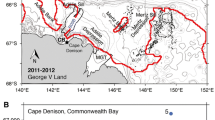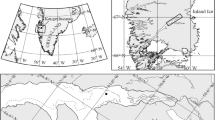Abstract
Antarctic sea ice and the cold waters surrounding the continent are key elements of the global climate system, influencing heat redistribution, oceanic circulation and the absorption of carbon dioxide from the atmosphere. However, the Southern Ocean is predicted to warm by 1–6°C over the next century, altering sea ice extent, thickness and permanence. To better understand the connections between coastal sea ice conditions and the functioning of Antarctica’s unique marine benthic ecosystems, we performed manipulative experiments on the seafloor at two southwestern Ross Sea sites with contrasting sea ice conditions. Benthic systems at both study sites were net heterotrophic during the study period (early November), with primary production most likely limited by light availability rather than nutrients. There was five times more fresh algal detrital material in benthic sediments at the site with the thinner, snow-free, annually formed sea ice, relative to the site with thicker, multiyear sea ice. This elevated quantity and quality of algal detrital matter corresponded with a significantly greater rate of sediment oxygen utilization by the benthos and an altered pathway of nitrogen regeneration (tighter coupling between nitrification and denitrification). Large benthic animals (brittle stars, Ophionotus victoriae) enhanced the efflux of dissolved inorganic nutrients from the sediment to the water column and played a greater role in nutrient regeneration at the site with more food. Although changes in sea ice characteristics in the Western Ross Sea are difficult to predict at present, large benthic organisms can be expected to have an expanded role in mediating the effects of elevated coastal productivity and detritus supply on ecosystem dynamics in this part of Antarctica.



Similar content being viewed by others
References
Aller RC. 1978. Experimental studies of changes produced by deposit feeders on pore water, sediment and overlying water chemistry. Am J Sci 278:1185–234.
Arrigo KR, Thomas DN. 2004. Large scale importance of sea ice biology in the Southern Ocean. Antarct Sci 16:471–86.
Arrigo KR, van Dijken GL. 2004. Annual changes in sea-ice, chlorophyll a, and primary production in the Ross Sea, Antarctica. Deep-Sea Res II 51:117–38.
Arrigo KR, Perovich DK, Pickart RS, Brown ZW, van Dijken GL et al. 2012. Massive phytoplankton blooms under Arctic sea ice. Science 336:1408.
Barry JP, Dayton PK. 1988. Current patterns in McMurdo Sound, Antarctica and their relationship to local biotic communities. Polar Biol 8:367–76.
Bergamasco A, Carniel S. 2000. Sensitivity analysis of a robust diagnostic general circulation model of the Ross Sea. J Mar Syst 27:3–36.
Blackburn TH, Blackburn ND. 1993. Coupling of cycles and global significance of sediment diagenesis. Mar Geol 113:101–10.
Blackburn TH, Hall POJ, Hulth S, Landén A. 1996. Organic-N loss by efflux and burial associated with a low efflux of inorganic N and with nitrate assimilation in Arctic sediments (Svalbard, Norway). Mar Ecol Prog Ser 141:283–93.
Caffrey JM, Sloth NP, Kaspar HF, Blackburn TH. 1993. Effect of organic loading on nitrification and denitrification in a marine sediment microcosm. Microb Ecol 12:159–67.
Cai W-J, Sayles FL. 1996. Oxygen penetration depths and fluxes in marine sediments. Mar Chem 52:123–31.
Cattaneo-Vietti R, Chiantore M, Misic C, Povero P, Fabiano M. 1999. The role of pelagic-benthic coupling in structuring littoral benthic communities at Terra Nova Bay (Ross Sea) and in the Straits of Magellan. Sci Mar 63:113–21.
Cummings VJ, Thrush SF, Norkko A, Andrew NL, Hewitt JE, Funnell GA, Schwarz A-M. 2006. Accounting for local scale variability in benthos: implications for future assessments of latitudinal trends in the coastal Ross Sea. Antarct Sci 18:633–44.
Cummings V, Hewitt J, Van Rooyen A, Currie K, Beard S, Thrush S, others . 2011. Ocean acidification at high latitudes: potential effects on functioning of the Antarctic bivalve Laternula elliptica. PLoS ONE 6:e16069.
Curry CW, Bennett RH, Hulbert MH, Curry KJ, Faas RW. 2004. Comparative study of sand porosity and a technique for determining porosity of undisturbed marine sediment. Mar Georesour Geotechnol 22:231–52.
Dayton PK. 1989. Interdecadal variation in an Antarctic sponge and its predators from oceanographic climate shifts. Science 245:1484–6.
Dayton PK, Oliver JS. 1977. Antarctic soft-bottom benthos in oligotrophic and eutrophic environments. Science 197:55–8.
Dayton PK, Robilliard GA, Paine RT, Dayton LB. 1974. Biological accommodation in the benthic community at McMurdo Sound, Antarctica. Ecol Monogr 44:105–28.
Dayton PK, Watson D, Palmisano A, Barry JP, Oliver JS, Rivera D. 1986. Distribution patterns of benthic microalgae standing stock at McMurdo Sound, Antarctica. Polar Biol 6:207–13.
Ericson JA, Ho MA, Miskelly A, King CK, Virtue P, Tilbrook B. 2011. Combined effects of two ocean change stressors, warming and acidification, on fertilization and early development of the Antarctic echinoid Sterechinus neumayeri. Polar Biol . doi:10.1007/s00300-011-1150-7.
Eyre BD, Ferguson AJP, Webb A, Maher D, Oakes JM. 2011. Denitrification, N-fixation and nitrogen and phosphorus fluxes in different benthic habitats and their contribution to the nitrogen and phosphorus budgets of a shallow oligotrophic sub-tropical coastal system (southern Moreton Bay, Australia). Biogeochemistry 102:111–33.
Farías L, Gracoa M, Ulloa O. 2004. Temporal variability of nitrogen cycling in continental-shelf sediments of the upwelling ecosystem off central Chile. Deep-Sea Res II 51:2491–505.
Fratt DB, Dearborn JH. 1984. Feeding biology of the Antarctic brittle star Ophionotus victoriae (Echinodermata: Ophiuroidea). Polar Biol 3:127–39.
Fyfe JC, Saenko OA, Zickfeld K, Eby M, Weaver AJ. 2007. The role of poleward-intensifying winds on Southern Ocean warming. J Clim 20:5391–400.
Glud RN, Khül M, Wenzhöfer F, Rysgaard S. 2002. Benthic microphytes of a high Arctic fjord: importance for ecosystem primary production. Mar Ecol Prog Ser 238:15–29.
Grebmeier JM, McRoy CP. 1989. Pelagic-benthic coupling on the shelf of the northern Bering and Chukchi Seas. III. Benthic food supply and carbon cycling. Mar Ecol Prog Ser 53:79–91.
Gypens N, Lancelot C, Soetaert K. 2008. Simple parameterisations for describing N and P diagenetic processes: application in the North Sea. Prog Oceanogr 76:89–110.
Hines ME, Orem WH, Lyons BW, Jones GE. 1982. Microbial activity and bioturbation-induced oscillations in pore water chemistry of estuarine sediments in spring. Nature 299:433–5.
Huettel M, Gust G. 1992. Impact of bioroughness on interfacial solute exchange in permeable sediments. Mar Ecol Prog Ser 89:253–67.
Hutchins DA, Mulholland MR, Fu F. 2009. Nutrient cycles and marine microbes in a CO2-enriched ocean. Oceanography 22:128–45.
Kellogg DE, Kellogg TB. 1982. Diatoms from brittle star stomach contents: implications for sediment reworking. Antarct J US 17:167–9.
Kim S, Thurber A, Hammerstrom K, Conlan K. 2007. Seastar response to organic enrichment in an oligotrophic polar habitat. J Exp Mar Biol Ecol 346:66–75.
Kinnard C, Zdanowicz CM, Fisher DA, Isaksson E, de Vernal A, Thompson LG. 2011. Reconstructed changes in Arctic sea ice over the past 1,450 years. Nature 479:509–13.
Lohrer AM, Thrush SF, Gibbs MM. 2004. Bioturbators enhance ecosystem function through complex biogeochemical interactions. Nature 431:1092–5.
McMinn A, Pankowskii A, Ashworth C, Bhagooli R, Ralph P, Ryan K. 2010. In situ net primary productivity and photosynthesis of Antarctic sea ice algal, phytoplankton and benthic algal communities. Mar Biol 157:1345–56.
Mermillod-Blondin F, Françoise-Carcaillet F, Rosenberg R. 2005. Biodiversity of benthic invertebrates and organic matter processing in shallow marine sediments: an experimental study. J Exp Mar Biol Ecol 315:187–209.
Needham HR, Pilditch CA, Lohrer AM, Thrush SF. 2011. Context specific bioturbation mediates changes to ecosystem functioning. Ecosystems . doi:10.1007/s10021-10011-19468-10020.
Norkko A, Thrush SF, Cummings VJ, Gibbs MM, Andrew NL, Norkko J, Schwarz A-M. 2007. Trophic structure of coastal Antarctic food webs associated with changes in food supply and sea ice extent. Ecology 88:2810–20.
Norling K, Rosenberg R, Hulth S, Grémare A, Bonsdorff E. 2007. Importance of functional biodiversity and species-specific traits of benthic fauna for ecosystem functions in marine sediment. Mar Ecol Prog Ser 322:11–23.
Obermüller BE, Morley SA, Barnes DKA, Peck LS. 2010. Seasonal physiology and ecology of Antarctic marine benthic predators and scavengers. Mar Ecol Prog Ser 415:109–26.
Reddy TE, Holland DM, Arrigo KR. 2010. Ross Ice Shelf cavity circulation, residence time, and melting: results from a model of oceanic chlorofluorocarbons. Cont Shelf Res 30:733–42.
Rysgaard S, Nielsen TG. 2006. Carbon cycling in a high-arctic marine ecosystem—Young Sound, NE Greenland. Prog Oceanogr 71:426–45.
Rysgaard S, Thamdrup B, Risgaard-Petersen N, Fossing H, Berg P, Christensen PB, Dalsgaard T. 1998. Seasonal carbon and nutrient mineralization in a high-Arctic coastal marine sediment, Young Sound, Northeast Greenland. Mar Ecol Prog Ser 175:261–75.
Rysgaard S, Nielsen TG, Hansen BW. 1999. Seasonal variation in nutrients, pelagic primary production and grazing in a high-Arctic coastal marine ecosystem, Young Sound, Northeast Greenland. Mar Ecol Prog Ser 179:13–25.
Rysgaard S, Kühl M, Glud RN, Hansen JW. 2001. Biomass, production and horizontal patchiness of sea ice algae in a high-Arctic fjord (Young Sound, NE Greenland). Mar Ecol Prog Ser 223:15–23.
Schwarz A, Hawes I, Andrew N, Norkko A, Cummings V, Thrush S. 2003. Macroalgal photosynthesis near the southern global limit for growth; Cape Evans, Ross Sea, Antarctica. Polar Biol 26:789–99.
Sejr MK, Jensen KT, Rysgaard S. 2000. Macrozoobenthic structure in a high-Arctic East Greenland fjord. Polar Biol 23:792–801.
Smetacek V, Nichol S. 2005. Polar ocean ecosystems in a changing world. Nature 437:362–8.
Smith WO, Marra J, Hiscock MR, Barber RT. 2000. The seasonal cycle of phytoplankton biomass and primary productivity in the Ross Sea, Antarctica. Deep-Sea Res II 47:3119–40.
Smith CR, Mincks S, DeMaster DJ. 2006. A synthesis of bentho-pelagic coupling on the Antarctic Shelf: food banks, ecosystem inertia and global climate change. Deep-Sea Res II 53:875–94.
Stammerjohn SE, Martinson DG, Smith RC, Yuan X, Rind D. 2008. Trends in Antarctic annual sea ice retreat and advance and their relation to El Nino-Southern Oscillation and Southern Annular Mode variability. J Geophys Res 113:C03S90.
Thomas DN. 2004. Frozen oceans: the floating world of pack ice. Natural History Museum, London, 224 pp.
Thomas DN, Dieckmann GS. 2002. Antarctic sea ice—a habitat for extremophiles. Science 295:641–4.
Thrush SF, Cummings VJ. 2011. Massive icebergs, alteration in primary food resources and change in benthic communities at Cape Evans, Antarctica. Mar Ecol. doi:10.1111/j.1439-0485.2011.00462.x.
Thrush SF, Dayton PK, Cattaneo-Vietti R, Chiantore M, Cummings VJ, Andrew NL, Hawes I, Kim S, Kvitek R, Schwarz A-M. 2006. Broad-scale factors influencing the biodiversity of coastal benthic communities of the Ross Sea. Deep-Sea Res II 53:959–71.
Thrush SF, Hewitt JE, Cummings VJ, Norkko A, Chiantore M. 2010. β-Diversity and species accumulation in Antarctic coastal benthos: influence of habitat, distance and productivity on ecological connectivity. PLoS ONE 5(7):e11899. doi:10.1371/journal.pone.0011899.
Vaughan DG, Doake CSM. 1996. Recent atmospheric warming and retreat of ice shelves on the Antarctic Peninsula. Nature 379:328–30.
Vopel K, Thistle D, Rosenberg R. 2003. Effect of the brittle star Amphiura filiformis (Amphiuridae, Echinodermata) on oxygen flux into the sediment. Limnol Oceanogr 48:2034–45.
Wing SR, McLeod RJ, Leichter JJ, Frew RD, Lamare MD. 2012. Sea ice microbial production supports Ross Sea benthic communities: influence of a small but stable subsidy. Ecology 93:314–23.
Acknowledgments
This study was funded by the New Zealand Ministry of Fisheries’ BioRoss portfolio, and NIWA. We thank Antarctica New Zealand, Scott Base staff and Latitudinal Gradient Project affiliates for excellent logistical support. Many at NIWA contributed to sample collection and analysis; special thanks to all K082 divers. We thank Paul Dayton, Rich Aronson and an anonymous reviewer for helpful suggestions on an earlier draft of the paper.
Author information
Authors and Affiliations
Corresponding author
Additional information
Author Contributions
AML, VJC and SFT conceived the study. AML and VJC performed the research. AML analysed the data. AML, VJC and SFT wrote the article.
Rights and permissions
About this article
Cite this article
Lohrer, A.M., Cummings, V.J. & Thrush, S.F. Altered Sea Ice Thickness and Permanence Affects Benthic Ecosystem Functioning in Coastal Antarctica. Ecosystems 16, 224–236 (2013). https://doi.org/10.1007/s10021-012-9610-7
Received:
Accepted:
Published:
Issue Date:
DOI: https://doi.org/10.1007/s10021-012-9610-7




